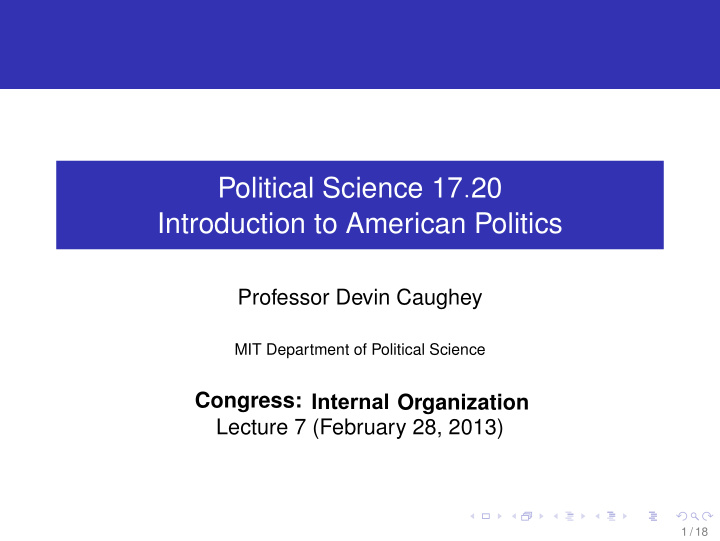



Political Science 17 . 20 Introduction to American Politics Professor Devin Caughey MIT Department of Political Science Internal Congress: Organization Lecture 7 (February 28, 2013) 1 / 18
Outline Institutional Solutions to Collective Action Problems 1 The Committee System Majority Party Control 2 Pivotal Politics 2 / 18
Outline Institutional Solutions to Collective Action Problems 1 The Committee System Majority Party Control 2 Pivotal Politics 3 / 18
Basic Problems Faced by Legislatures Last lecture: Individual rationality = ⇒ collective irrationality Collective goods (balanced budget, party reputation, etc.) Lack of information and expertise Time limitations Transaction costs (instability) 4 / 18
Institutional Solutions Institutions that (partially) solve these problems: Committee system 1 2 Majority-party control Each set of institutions solves problems in different ways and encourages different kinds of politics/policymaking. Relative importance has evolved over time due to formal and informal changes in Congress. Need for rules, organization greater in House than in (smaller) Senate 5 / 18
Committees: Origins and Purpose Congressional committees predate Constitution Idea: Let small group, possibly with special expertise, work on problem or issue (e.g., Declaration of Independence) Information, expertise, specialization Committees as agents of the chamber as a whole Problems: Incentivize acquisition of expertise 1 Preference outliers 2 6 / 18
Evolution of the Committee System Early 1800s: Ad hoc to standing Early 1900s: Seniority rule 1920s–1970s: Strong, autonomous committee system 1970s–present: Increasing party control over committees 7 / 18
Politics of the Committee System Norm of deference → logroll Non-ideological, universalistic, distributive politics Preference outliers dominate their area of interest Special role of House Rules Committee (now partisan) 8 / 18
Mechanisms of Party Control Leaders (Speaker, majority leader, etc.) are agents of the majority party caucus, not the chamber as a whole. Hastert Rule: “majority of the majority” Speaker of the House is empowered by majority caucus to influence committee membership, control agenda (what is voted on when → Rules), etc. Senate majority leader has much less power. 9 / 18
Conditional Party Government Aldrich & Rohde: Amount of power the majority party is willing to cede its leadership depends on its internal homogeneity and its polarization relative to the minority. 10 / 18
Ideological Polarization Over Time House 1879-2012 Party means on liberal-conservative dimension 0.6 0.4 e v i t a 0.2 v r e s n 0.0 o C - l -0.2 a r e b i -0.4 L -0.6 1879 1887 1895 1903 1911 1919 1927 1935 1943 1951 1959 1967 1975 1983 1991 1999 2007 Republicans Southern Democrats Democrats Northern Democrats Image by MIT OpenCourseWare. 11 / 18
Outline Institutional Solutions to Collective Action Problems 1 The Committee System Majority Party Control 2 Pivotal Politics 12 / 18
(How) Do Parties Matter? Krehbiel: Given the distribution of preferences in Congress, does it matter what the majority party is? All we need to know is who are the pivotal voters. 13 / 18
Supermajority Institution 1: The Senate Filibuster Majoritarian (50 % + 1) Supermajoritarian (60 % ) The right/conservative filibuster pivot (F R ), the 60th most liberal member of the 100-member Senate, is pivotal to the passage of proposals that move policy to the left. 14 / 18
The Gridlock Interval Status quos between F L and F R cannot be beaten by any proposed policy shift = ⇒ gridlock (policy stasis) 15 / 18
Supermajority Institution 2: The Presidential Veto A 2/3 supermajority is needed to override a presidential veto, so the gridlock interval extends to the veto pivot (V) on the president’s side of the median. Partisan change in the presidency (e.g., Bush to Obama) “releases” policies btwn veto and filibuster pivots (green) → presidential “honeymoon” 16 / 18
The Case of Health Care, 2009–10 (111 th Congress) Healthcare reform (Q t ) barely passed Senate (60 votes). More conservative than liberal Democrats (e.g., V) wanted. “Cornhusker kickback” to buy off conservative Democrat Ben Nelson of Nebraska, the filibuster pivot (F R ). (Democrats lost supermajority before final passage and had to use special majoritarian procedure, “reconciliation”) 17 / 18
The Role of Parties in Congress Even if parties have little influence over roll-call votes, they still have two very important roles: Structure politics along a single ideological dimension 1 → Example: Abortion + gun control + healthcare mandate Influence/control the alternatives 2 → Example: Clinton impeachment 18 / 18
MIT OpenCourseWare http://ocw.mit.edu 17.20 Introduction to American Politics Spring 2013 For information about citing these materials or our Terms of Use, visit: http://ocw.mit.edu/terms .
Recommend
More recommend